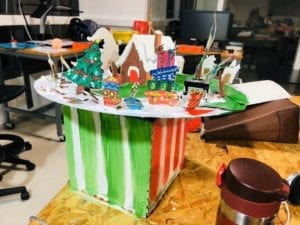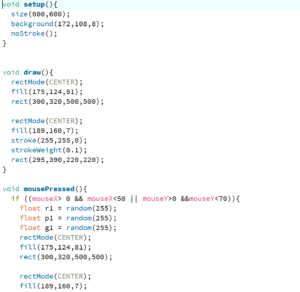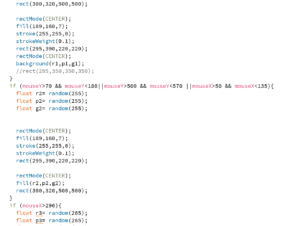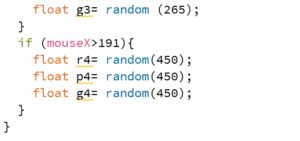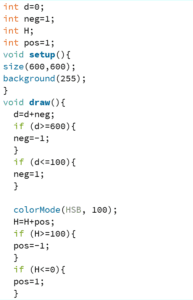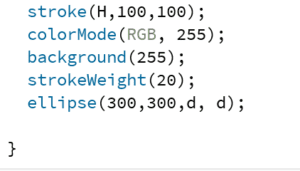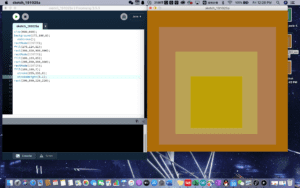Merry Christmas—Vivien Hao—Professor Inmi
Context and significance:
In my previous group project, we were mainly focused on solving an existing global issue. For this midterm project, my partner and I wanted to do something different. Our initial intention was to make the process of learning music to be more interesting to kids. Since both of us started learning the piano when we were young, so we understand the feelings to be bored by the black and white keyboard that lies in front of us. With that being said, it is obvious the targeted group of audiences for our project would be kids who have not started learning music but have the interest to do so. It can also be interesting for adults who do not have much musical knowledge. They might get a self-satisfied feeling when playing with the project. One of my friends came up to us and played the project for a couple of minute, and he told me that he felt like he was also a music while he was playing with it. He felt satisfied.
Before we started working on this project, we had done some research on how to make our project interactive. I went back to the projects that I have researched for the group research project. “The Evil Eye-Optical audio record by Indianen” was still something that stood out to me. In that project, the artists really required the participants to give inputs to the project constantly. For example, the participant was expected to put an audio record to the project in order to move on to the next step. Then it would ask the participant to do another task, etc. When I was introducing this project to some of my friends, they were questioning the purpose of this project. They were making a point by saying that music box is an object that has been existed for so long. So how is my project different from the existing music boxes in the market? I remember I have told them that our project does function like a music box, but it is not just an ordinary music box. Our project requires more interaction between the project and the participant. The participant has to twist the potentiometer in order for the images on the motor to be moving along with the music. However, we did not have this part ready for the final presentation because our jump wires kept falling off. But it could have worked if the wires were working. For the future projects, if we could figure out a way to solve the wire issue, I think we would be able to build more.
Conception and design:
Throughout the entire process, we tried to think from the participants’ perspective and imagine how they would interact with this project. However, we did have some biases since we already have so much information about this project. We were not aware of some existing issues. For example, we were not aware of the issue that participants might move the plate in big circles and cannot figure out the music being played or might even be ended up breaking the project. And then she gave us the advice to make the plate into a larger piece that it would add difficulties for them to move the plate super quickly. We took that idea and made a bigger plate. And it did work out. Participants could not move the plate too quickly. We used 3D printing for our plates. For the first plate, we used wood. For the larger plate, we decided to use plastic material instead. We just thought that plastic might be stronger than wood.
Fabrication and production:
From my perspective, I think the most significant step in my production process would be figuring out the codes and how to correctly build the breadboards. We were experiencing difficulties with the codes and the wires. I do not even know how many times that our project would not function in an expected way because we had a small issue in the codes, or one wire had been connected at the wrong spot. For future projects, I think I should be more thoughtful and careful when I am building a breadboard because sometimes one small error would prevent the project from functioning properly. In the User Testing Session, we did not have a box ready. There were no Christmas decorations on the table. All we had was the motors and the small plate that they could play with. I could tell that the participants were a bit confused about what they should do and how is the purpose of the project. We had realized this issue. After the session, we had decided to print the box immediately and create some Christmas decorations on the box that would give participants an obvious outcome to their inputs. After we added this to our project, I think the final presentation went better than the User Testing.
Conclusions:
The major goal for our project was to encourage musical interests among children and adults who do not have much prior knowledge of music. The end results for the projects do align with our definition of interaction. The participant had to constantly interact with the project in order to have an outcome. The project itself would not give the participant many outcomes unless he chose to interact with it. However, one part of the project that hinders the definition of interaction. The stepper motor seemed to be a decoration. But in fact, it was also meant to require interaction. Like I have mentioned earlier, if we could solve the wire issue, then the project would fully meet our expectations of being interactive. If that issue was being solved, then the project would not give any outcomes to the participant if he chose not to interact with it. The audience, more or less, did interact with the project in expected ways. They were moving the plate and trying to figure out the music. Some of them started out at a fast pace ,and some started slower. They were adjusting their speed in order to figure out the music being played. If we had more time, I think we might add different scenes on the box and put different music with each scene. I think that would make the box more interesting. In addition, I would also like to make this box reusable. For example, I would like to make the scenes on the box to be replaceable. After this project, I think we definitely have learned some technical lessons. Moreover, I personally have also learned that for future projects, I should try to ask people for feedback and suggestions before the final decision. For this project, if we had asked the Professors and our friends for some advice, I think the project would be in a better format. Even though the project is far from being perfect, but I think it could be considered a small accomplishment for both of us. I personally think that for this project, we had done some good plannings. We were not procrastinating things to the last minute. I think overall, the project did meet up expectations, encouraging musical interests among kids and adults who do not have prior knowledge in music. But I think the project could be more interactive. And if we could master our technical skills, in the future we could really build something that could be used to deliver this idea better.
571419f9b354426c85180057515dcfcf
